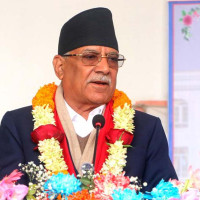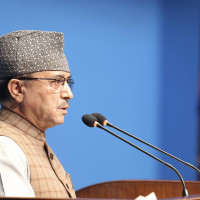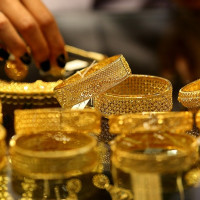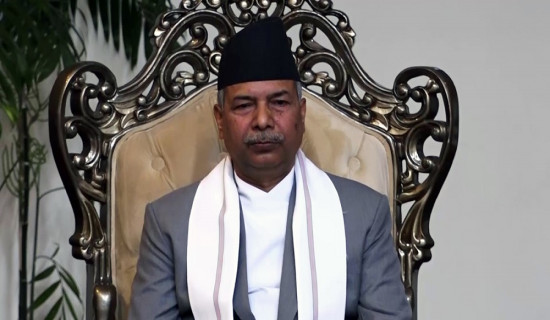- Friday, 16 January 2026
Have you visited the real Pimbahal?
Lalitpur, Jan. 16: Kristin Bajracharya finds solace near the Jaga Madu Pond in Lalitpur Metropolitan City-20 every day after work. “The area is always buzzing with life and exudes a cheerful ambience,” said the 29-year-old.
“This place – Pimbahal – can make you forget all your cares,” she added with a smile.
Likewise, 33-year-old Bigyan Khanal comes here every other week to indulge in what he claims are the unparalleled delights of Pimbahal crisps. “Ain’t no crisps like Pimbahal crisps,” he proclaimed.
However, the name Pimbahal brings a question to mind: where is the Bahal, the Buddhist monastic courtyard, of this Bahal? The Rising Nepal put this question to a dozen people, both locals and visitors, on Sunday, and received varied responses. Some thought the Gavarmapintha Mahavihar to the west of the Jaga Madu Pond (which itself is referred to as Pimbahal Pond) was Pimbahal while others guessed that it could be the locality around the prominent white Ashok Stupa. Some also admitted they did not know.
But a person who did know was local Triratna Shakya. Shakya, 85, is the Thakali Aju (Eldest among the elders) of Mubahal and is a member of the communal trust that conducts ritual worship (Puja) at the Ashok Stupa.
Talking to The Rising Nepal, he clarified that the Gavarmapintha Mahavihar was not Pimbahal, but actually the Mubahal he leads, and informed the area around the Jaga Madu Pond earned the name Pimbahal simply because it was in proximity to the erstwhile Pimbahal.
Hold on a second! Erstwhile? Does this mean that the Bahal no longer exists? “Not in the form you’d expect,” Shakya replied, walking into a confined quadrangle less than 50 metres north of the white Stupa.
The quad, surrounded by houses on three sides, is a tiny – and surprisingly quiet – space invisible from the main street (if you can call it that). It is paved with tiles and has a quaint well at the centre.
“This used to be Pimbahal,” Shakya, a retired Chief Survey Officer of the Survey Department, revealed. To laypeople, nothing in the precinct would betray its history as a wing of a Buddhist monastery. But Shakya is no layperson. He is the ‘eldest of the elders’ after all.
“And look at this,” despite his age he was able to run to what looked like the ruins of a building. “Look at this!” he stressed.
“This could be where [Pimbahal’s] main deity was housed,” he hypothesised. “I remember once seeing his throne here,” he said, pointing to the top of the grass-and-weed-covered mound.
“This is where Pimbahal was,” Shakya reiterated.
Where the gods went silent
Quoting Varnavajra Vajracarya’s book ‘Cwabaha Karunamaya Bakha’ (Tales of Chobar Karunamaya), researcher John Kerr Locke SJ, in his 1980 publication ‘Karunamaya,’ associates Pimbahal with Manjushree, the figure who, according to Buddhist legends, made Kathmandu Valley inhabitable by draining the lake that covered it.
Locke writes that, aeons after first making Kathmandu liveable, Manjushree returned to pray at the Sri Tin Jyotirupa Swayambhu accompanied by the Kashyap Tathagat.
During their visit, the two felt they needed to stay in the Valley to teach and guide the people here. So, they set up a Vihar (monastery) at Pimbahal and appointed an Acharya and his family as their dyo palas (priestly attendants).
However, after several generations, disputes arose among the Acharya’s descendants about who had the right to serve the two divinities. Based on Vajracarya’s work, Locke writes that this dispute was solved when the heirs decided to take turns.
But, by this time, the world had entered the most sinful of the eras, the Kali Yuga, and the two deities decided that they could not continue to stay at Pimbahal and pay direct attention to their devotees. So, they decided to disappear into their images. Locke describes, “While they would continue to grant favours to the people, they decided they would no longer speak with them.”
The Dyo Palas, their relatives and the ordinary worshippers, though, were not aware of this decision. Everyone thought the Palas failed to keep the gods happy and killed them all, except for one old man.
This violence made the old man, who was spared out of respect for his advanced age, angry. “What is the use of worshipping you?” he rebuked the gods. “Because of you, my whole family has been murdered.”
In his rage, the man removed the images of Manjushree and Kashyap and threw them into a river at the Arya Tirtha and the Shanti Tirtha respectively. One Hem Acharya later recovered Kashyap’s image and consecrated it at Patan’s ‘Golden Temple.’
As for the Manjushree figure, the river carried it to a place called Jaya Tirtha where a man named Suval Acharya found it. Through his Sadhana, this man removed the life force from the figure and transferred it to another statue that he then placed at the top of the Kakshapal Hill at Chobar. This statue later got the name Anandadi Lokeshwor.
Thus, if the legend is to be believed, Pimbahal is a sacred land where divine beings once lived.
So, next time you visit Pimbahal, enjoy the vibrant atmosphere, immerse yourself in the lively surroundings and seek out the divine sanctuary that once thrived here. When at Pimbahal, do not forget to visit the real Pimbahal.








-square-thumb.jpg)




